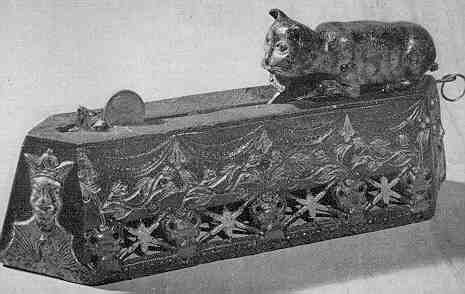Springing Cat Bank
by F.H. Griffith - HOBBIES Magazine - September, 1952

A very rare and unusual bank, the Springing Cat, is our choice to occupy the twelfth position in the numerical listing of mechanical banks.
The bank was patented July 18, 1882 by Charles A. Bailey and manufactured completely in his own workshop in Cobalt, Conn. This bank was made before he became affiliated with the J. and E. Stevens Company in Cromwell, Conn. Unlike all banks covered so far, with the exception of the Freedman’s, it is not made of cast iron, the base and figures being lead or pewter-like metal and the bottom plate of wood with a round wood coin trap. Some people erroneously think that this bank is white metal. An unusual feature of the bank is the fact that the base parts are assembled by means of soldering and the wood base plate held in place by small brads.
Mr. Bailey employed a well known theme with clever action when he designed the Springing Cat Bank and it operates as follows: The cat is placed in the position shown in the picture at the right end of the bank. A coin is then inserted, as shown, in a slot provided for this purpose. The ring type lever is pulled and the cat springs through the air. At the same time a little mouse appears and knocks the coin in the bank and immediately disappears back into the base just as the cat completes his leap toward him. During operation the cat’s mouth which is hinged swings open and closes. The bank is painted with a green base embellished with red and gold figures, the cat is yellow with black striping, and the mouse, of course, is gray. The specimen shown is original throughout and the paint is in exceptionally nice condition for this particular bank.
Another unusual point of interest in connection with the bank is its very definite foreign looking appearance. There are strange Hindu-like figures on each end of the base and the cat itself is a wild-eyed eerie-looking figure. It was at first believed to be of foreign manufacture until the patent papers turned up identifying the bank with Mr. Bailey.
In collecting mechanical banks there have been many unusual and interesting circumstances surrounding the obtaining of individual specimens. The story in back of the eventual retaining of the Springing Cat Bank now in the writer’s collection is one of the more intriguing of these stories
Some years ago in New England in the early 30’s the first specimen of the Springing Cat that had turned up was found in Worcester, Mass. Of course this was in the early stages of collecting banks as far as the writer goes and it offered great possibilities from an advantageous trading standpoint. It is, of course, never a good policy to trade any rare item: however, in the formative stages of a collection hobby there are certain advantages to it from the angle of adding a number of specimens at one time. Later on, however, as the collection progresses the collector is very apt to have remorse and regret due to the fact that he let some rare item go which he didn’t realize at the time might never be replaced. Certainly the Springing Cat Bank in the case of the writer has been the exception that would prove this rule.
As mentioned above, he traded the first one to a well-known collector and at the time it was a very advantageous trade so far as adding a number of specimens to the collection. Not more than a year passed, when he turned up the second one of the banks in an antique shop in Boston, Mass. At the time this also seemed a little too odd an item to keep and a trade was made with the late James C. Jones, a well-known collector. A number of intervening years and an increasing degree of remorse and regret ensued before the opportunity arose a few years back to obtain again a Springing Cat Bank. This time the bank was purchased from A.L. Cooper of Dayton, Ohio.
When this specimen was obtained he decided that the third time was a charm and this one definitely would not leave his collection. However, fate with its peculiar workings, decreed that at this moment the opportunity of a lifetime should arise to obtain a Freedman’s Bank, which meant trading the Springing Cat before it even had a chance to be placed in with his other banks. It might be pointed out that the writer had long ago definitely made up his mind that he would one way or another obtain the first Freedman’s or Clown, Harlequin and Columbine that was offered to him even if it was necessary to dispose of some other rare bank. It was with very good fortune, not too long after getting the Freedman’s Bank, that J.P. Hurd of Beverly, Mass., obtained a Springing Cat Bank from an original owner for the writer, and this is the one pictured.
There are five or possibly six of these banks known to exist in collections and it is an unusual circumstance to have owned four of them. Since the writer has been fortunate enough to have acquired the top banks that he has always wanted, it is safe to assume now that the Springing Cat Bank shown is a permanent fixture in the collection.
In closing, the writer might suggest that it isn’t usually advisable to trade rare items from a collection even in the early stages. After all, the real value and greatest pleasure lies in the rarities, not in the quantity or number of items in the collection. Here again the collector must judge for himself.
